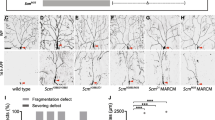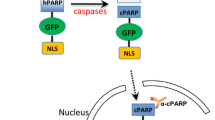Abstract
Developmentally regulated programmed cell death (PCD) is one of the key cellular events for precise controlling of neuronal population during postembryonic development of the central nervous system. Previously we have shown that a group of corazonin-producing peptidergic neurons (vCrz) undergo apoptosis in response to ecdysone signaling via ecdysone receptor (EcR)-B isoforms and Ultraspiracle during early phase of metamorphosis. Further utilizing genetic, transgenic, and mosaic analyses, we have found that TGF-β signaling mediated by a glia-produced ligand, Myoglianin, type-I receptor Baboon (particularly Babo-A isoform) and dSmad2, is also required autonomously for PCD of the vCrz neurons. Our studies show that TGF-β signaling is not acting epistatically to EcR or vice versa. We also show that ectopic expression of a constitutively active phosphomimetic form of dSmad2 (dSmad2PM) is capable of inducing premature death of vCrz neurons in larva but not other larval neurons. Intriguingly, the dSmad2PM-mediated killing is completely suppressed by coexpression of a dominant-negative form of EcR (EcRDN), suggesting that EcR function is required for the proapoptotic dSmad2PM function. Based on these data, we suggest that TGF-β and ecdysone signaling pathways act cooperatively to induce vCrz neuronal PCD. We propose that this type of two-factor authentication is a key developmental strategy to ensure the timely PCD of specific larval neurons during metamorphosis.












Similar content being viewed by others
References
Sisk CL, Zehr JL (2005) Pubertal hormones organize the adolescent brain and behavior. Front Neuroendocrinol 26:163–174
Gogtay N, Giedd JN, Hayashi KM, Greenstein D, Vaituzis AC, Nugent TF 3rd, Herman DH, Clasen LS, Toga AW, Rapoport JL, Thompson PM (2004) Dynamic mapping of human cortical development during childhood through early adulthood. Proc Natl Acad Sci USA 101:8174–8179
Huttenlocher PR, Dabholkar AS (1997) Regional differences in synaptogenesis in human cerebral cortex. J Comp Neurol 387:167–178
Lenroot RK, Giedd JN (2006) Brain development in children and adolescents: insights from anatomical magnetic resonance imaging. Neurosci Biobehav Rev 30:718–729
Petanjek Z, Judas M, Simic G, Rasin MR, Uylings HB, Rakic P, Kostovic I (2011) Extraordinary neoteny of synaptic spines in the human prefrontal cortex. Proc Natl Acad Sci USA 108:13281–13286
Koss WA, Lloyd MM, Sadowski RN, Wise LM, Juraska JM (2015) Gonadectomy before puberty increases the number of neurons and glia in the medial prefrontal cortex of female, but not male rats. Dev Psychobiol 57:305–312
Markham JA, Morris JR, Juraska JM (2007) Neuron number decreases in the rat ventral, but not dorsal, medial prefrontal cortex between adolescence and adulthood. Neurosci 144:961–968
Willing J, Juraska JM (2015) The timing of neuronal loss across adolescence in the medial prefrontal cortex of male and female rats. Neurosci 301:268–275
Awad TA, Truman JW (1997) Post-embryonic development of the midline glia in the CNS of Drosophila: Proliferation, programmed cell death, and endocrine regulation. Dev Biol 187:283–297
Choi YJ, Lee G, Park JH (2006) Programmed cell death mechanisms of identifiable peptidergic neurons in Drosophila melanogaster. Development 133:2223–2232
Robinow S, Talbot WS, Hogness DS, Truman JW (1993) Programmed cell death in the Drosophila CNS is ecdysone-regulated and coupled with a specific ecdysone receptor isoform. Development 119:1251–1259
Truman JW (1990) Metamorphosis of the central nervous system of Drosophila. J Neurobiol 21:1072–1084
Winbush A, Weeks JC (2011) Steroid-triggered, cell-autonomous death of a Drosophila motoneurons during metamorphosis. Neural Dev 6:15
Lee G, Wang Z, Sehgal R, Chen C-H, Kikuno K, Hay B, Park JH (2011) Drosophila caspases involved in developmentally regulated programmed cell death of peptidergic neurons during early metamorphosis. J Comp Neurol 519:34–48
Lee G, Sehgal R, Wang Z, Park JH (2019) Ultraspiracle-independent anti-apoptotic function of ecdysone receptors is required for the survival of larval peptidergic neurons via suppression of grim expression in Drosophila melanogaster. Apoptosis 24:256–268
Lee G, Kikuno K, Sehgal R, Wang Z, Nair S, Chen C-H, Hay B, Park JH (2013) Essential role of grim-led programmed cell death for the establishment of Corazonin-producing peptidergic nervous system during embryogenesis and metamorphosis in Drosophila melanogaster. Biol Open 2:283–294
Lee G, Kikuno K, Nair S, Park JH (2013) Mechanisms of post-ecdysis-associated cell death of peptidergic neurons in Drosophila melanogaster. J Comp Neurol 521:3972–3991
Draizen TA, Ewer J, Robinow S (1999) Genetic and hormonal regulation of the death of peptidergic neurons in the Drosophila central nervous system. J Neurobiol 38:455–465
Lee G, Kim J, Kim Y, Yoo S, Park JH (2018) Identifying and monitoring neurons that undergo metamorphosis-regulated cell death (metamorphoptosis) by a neuron-specific caspase sensor (Casor) in Drosophila melanogaster. Apoptosis 23:41–53
Robinow S, Draizen TA, Truman JW (1997) Genes that induce apoptosis: transcriptional regulation in identified, doomed neurons of the Drosophila CNS. Dev Biol 190:206–213
Lee T, Marticke S, Sung C, Robinow S, Luo L (2000) Cell-autonomous requirement of the USP/EcR-B ecdysone receptor for mushroom body neuronal remodeling in Drosophila. Neuron 28:807–818
Zheng X, Wang J, Haerry TE, Wu AY, Martin J, O'Connor MB, Lee CH, Lee T (2003) TGF-beta signaling activates steroid hormone receptor expression during neuronal remodeling in the Drosophila brain. Cell 112:303–315
Awasaki T, Huang Y, O'Connor MB, Lee T (2011) Glia instruct developmental neuronal remodeling through TGF-β signaling. Nat Neurosci 14:821–823
Zheng X, Zugates CT, Lu Z, Shi L, Bai JM, Lee T (2006) Baboon/dSmad2 TGFbeta signaling is required during late larval stage for development of adult-specific neurons. EMBO J 25:615–627
Boulanger A, Farge M, Ramanoudjame C, Wharton K, Dura J-M (2012) Drosophila motor neuron retraction during metamorphosis is mediated by inputs from TGF-β/BMP signaling and orphan nuclear receptors. PLoS One 7:e40255
Morikawa M, Derynck R, Miyazono K (2016) TGF-β and the TGF-β Family: Context-dependent roles in cell and tissue physiology. Cold Spring Harb Perspect Biol 2016 8:a021873
Sanchez-Capelo A (2005) Dual role for TGF-beta1 in apoptosis. Cytokine Growth Factor Rev 16:15–34
Schuster N, Krieglstein K (2002) Mechanisms of TGF-beta-mediated apoptosis. Cell Tissue Res 307:1–14
Duenker N (2005) Transforming growth factor-β (TGF-β) and programmed cell death in the vertebrate retina. Int Rev Cytol 245:17–43
Franke AG, Gubbe C, Beier M, Duenker N (2006) Transforming growth factor-β and bone morphogenetic proteins: cooperative players in chick and murine programmed retinal cell death. J Comp Neurol 495:263–278
Choi S-H, Lee G, Park JH (2008) Spatial regulation of Corazonin neuropeptide expression requires multiple cis-acting elements in Drosophila melanogaster. J Comp Neurol 507:1184–1195
Gesualdi SC, Haerry TE (2007) Distinct signaling of Drosophila Activin/TGF-β family members. Fly 1:212–221
Peterson AJ, O'Connor MB (2014) Strategies for exploring TGF-β signaling in Drosophila. Methods 68:183–193
Marques G, Haerry TE, Crotty ML, Xue M, Zhang B, O’Connor MB (2003) Retrograde Gbb signaling through the Bmp type 2 receptor Wishful Thinking regulates systemic FMRFa expression in Drosophila. Development 130:5457–5470
Simin K, Bates EA, Homer MA, Letsou A (1998) Genetic analysis of punt, a type II Dpp receptor that functions throughout the Drosophila melanogaster life cycle. Genetics 148:801–813
Awasaki T, Lai S-L, Ito K, Lee T (2008) Organization and postembryonic development of glial cells in the adult central brain of Drosophila. J Neurosci 28:13742–13753
Schwabe T, Bainton RJ, Fetter RD, Heberlein U, Gaul U (2005) GPCR signaling is required for blood-brain barrier formation in Drosophila. Cell 123:133–144
Yu XM, Gutman I, Mosca TJ, Iram T, Özkan E, Garcia KC, Luo L, Schuldiner O (2013) Plum, an immunoglobulin superfamily protein, regulates axon pruning by facilitating TGF-β signaling. Neuron 78:456–468
Brummel T, Abdollah S, Haerry TE, Shimell MJ, Merriam J, Raftery L, Wrana JL, O’Connor MB (1999) The Drosophila activin receptor baboon signals through dSmad2 and controls cell proliferation but not patterning during larval development. Genes Dev 13:98–111
Lee T, Luo L (1999) Mosaic analysis with a repressible cell marker for studies of gene function in neuronal morphogenesis. Neuron 22:451–461
Jensen PA, Zheng X, Lee T, O'Connor MB (2009) The Drosophila Activin-like ligand Dawdle signals preferentially through one isoform of the Type-I receptor Baboon. Mech Dev 126:950–957
Ng J (2008) TGFβsignals regulate axonal development through distinct Smad-independent mechanisms. Development 135:4025–4035
Parker L, Ellis JE, Nguyen MQ, Arora K (2006) The divergent TGF-beta ligand Dawdle utilizes an activin pathway to influence axon guidance in Drosophila. Development 133:4981–4991
Serpe M, O’Connor MB (2006) The metalloprotease tolloid-related and its TGF-β-like substrate Dawdle regulate Drosophila motoneuron axon guidance. Development 133:4969–4979
Zhu CC, Bonne J, Jensen PA, Hanna S, Podmenski L, Locke J, Doe CQ, O'Connor MB (2008) Drosophila Activin-β and Activin-like product Dawdle function redundantly to regulate proliferation in the larval brain. Development 135:513–521
Lo PC, Frasch M (1999) Sequence and expression of myoglianin, a novel Drosophila gene of the TGF-beta superfamily. Mech Dev 86:171–175
Truman JW, Talbot WS, Farhbach SE, Hogness DS (1994) Ecdysone receptor expression in the CNS correlates with stage-specific responses to ecdysteroids during Drosophila and Manduca development. Development 120:219–234
Tasdemir-Yilmaz OE, Freeman MR (2014) Astrocytes engage unique molecular programs to engulf pruned neuronal debris from distinct subsets of neurons. Genes Dev 28:20–33
Gibbens YY, Warren JT, Gilbert LI, O’Connor MB (2011) ) Neuroendocrine regulation of Drosophila metamorphosis requires TGFβ/Activin signaling. Development 138:2693–2703
Lee-Hoeflich ST, Zhao X, Mehra A, Attisano L (2005) The Drosophila type II receptor, Wishful thinking, binds BMP and myoglianin to activate multiple TGFβ family signaling pathways. FEBS Lett 579:4615–4621
Shi Y, Massague J (2003) Mechanisms of TGF-beta signaling from cell membrane to the nucleus. Cell 113:685–700
Nickel J, Dijke PT, Mueller TD (2017) TGF-βfamily co-receptor function and signaling. Acta Biochim Biophys Sin 50:12–36
Awasaki T, Ito K (2004) Engulfing action of glial cells is required for programmed axon pruning during Drosophila metamorphosis. Curr Biol 14:668–677
Acknowledgements
We are greatly indebted to Michael O’Connor (Univ. of Minnesota) for the provision of numerous fly strains used here. We also thank T. Lee (Janelia Farm), S. Robinow (Univ. of Hawaii), P. Cherbas (Indiana Univ.), and B. Hay (Caltech) for their kind donation of fly lines, and an anonymous reviewer for the helpful suggestions. The work was supported in part by NSF Grant (IOS-0919797), NIH Grant (R15-GM114741) and by Hunsicker research incentive award (Univ. of Tennessee).
Author information
Authors and Affiliations
Corresponding author
Additional information
Publisher's Note
Springer Nature remains neutral with regard to jurisdictional claims in published maps and institutional affiliations.
Electronic supplementary material
Below is the link to the electronic supplementary material.
Supplementary material 1 (PPTX 1737 kb)
Supplemental Fig. 1 Ectopic expression of dSmad2PM did not kill larval neurons expressing other peptidergic neurons. a Control CCAP neuropeptide-expressing larval neurons in WL3 (n = 14, genotype: UAS-mCD8GFP/+; ccap-gal4/+). b Ectopic expression of dSmad2PM in CCAP neurons did not kill them (n = 7, genotypes: UAS-mCD8GFP/+; UAS-dSmad2PM/+; ccap-gal4/+). c DILP2-expressing peptidergic neurons in the larval brain at WL3 (n = 5, genotypes: UAS-mCD8GFP/+; dilp2-gal4/+). d Ectopic expression of dSmad2PM did not kill DILP2 neurons (n = 3, genotype: UAS-mCD8GFP/+; dilp2-Gal4/UAS-dSmad2PM). e MIP-expressing peptidergic larval neurons in the CNS of WL3 (n = 3, UAS-mCD8GFP/+; mip-gal4/+). f Ectopic expression of dSmad2PM did not kill MIP-neurons (n = 3, genotype: UAS-mCD8GFP/+; UAS-dSmad2PM/+; mip-gal4). Scale bars, 100 µm (A), 50 µm (C).
Rights and permissions
About this article
Cite this article
Wang, Z., Lee, G., Vuong, R. et al. Two-factor specification of apoptosis: TGF-β signaling acts cooperatively with ecdysone signaling to induce cell- and stage-specific apoptosis of larval neurons during metamorphosis in Drosophila melanogaster. Apoptosis 24, 972–989 (2019). https://doi.org/10.1007/s10495-019-01574-4
Published:
Issue Date:
DOI: https://doi.org/10.1007/s10495-019-01574-4




